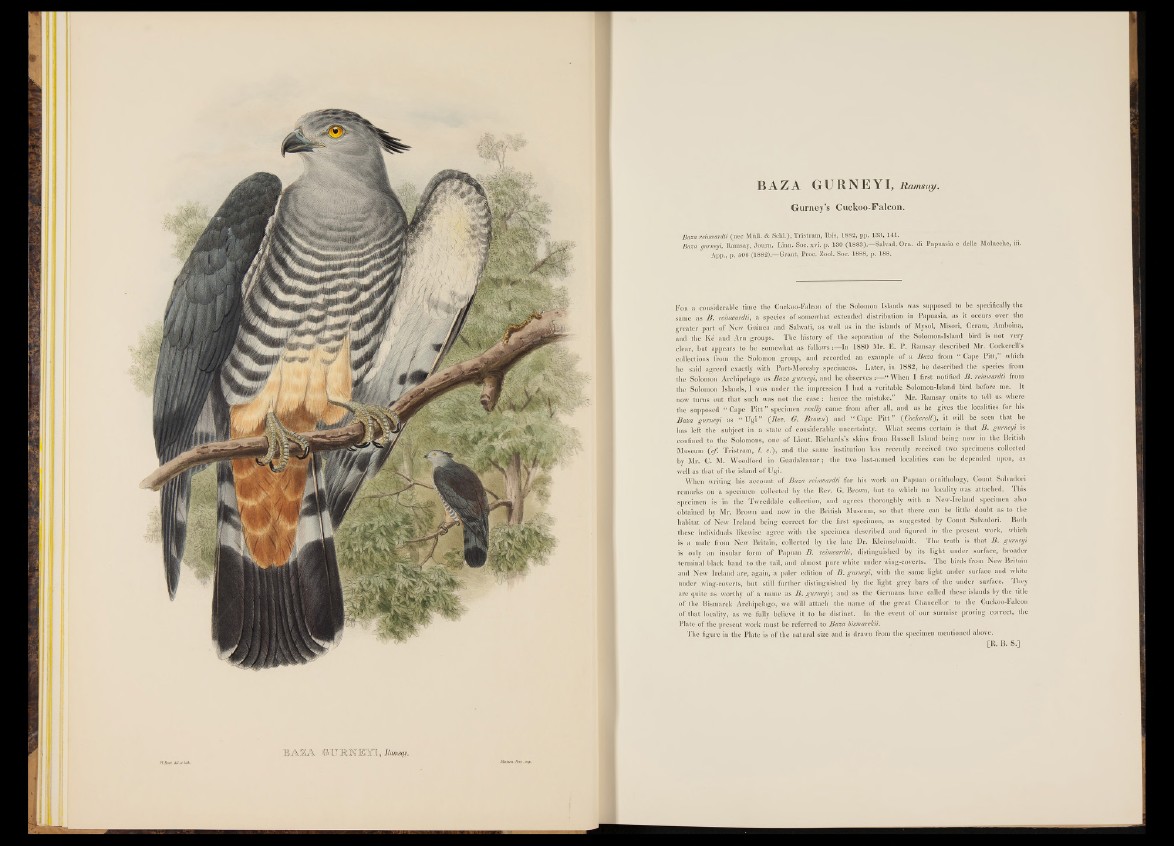
BOB
B A Z A G 1T3R N E Y I 9 Rams®.
BAZA GURNEY I, Ramsui/,
Gurney’s Cuckoo-Falcon.
Baza reinwardti (nec Müll. & Schl.), Tristram, Ibis, 1882, pp. 133, 141.
Baza gurneyi, Ramsay, Journ. Linn. Soc. xvi. p. 130 (18 8 3 ).—Salvad. Orn. di Papuasia e delle Molucche, iii.
App., p. 506 (1882).— Grant, Proc. Zool. Soc. 1888, p. 188.
F ok a considerable time the Cuckoo-Falcon o f the Solomon Islands was supposed t o be specifically the
same as B . reinwardti, a species of somewhat extended distribution in Papuasia, as it occurs over the
greater part o f New Guinea and Salwati, as well as in the islands of Mysol, Misori, Ceram, Amboina,
and the Ke and Aru groups. The history of the separation o f the Solomon-Island bird is not very
clear, but appears to be somewhat as follows:—In 1880 Mr. E. P. Ramsay described Mr. Cockerells
collections from the Solomon group, and recorded an example o f a Baza from “ Cape Pitt*” which
lie said agreed exactly with Port-Moresby specimens. Later, in 1882, he described the species troin
the Solomon Archipelago as Baza gurneyi, and he observes :— “ When I first notified B . reinwardti from
the Solomon Islands, I was under the impression I had a veritable Solomon-Island bird before me. It
now turns out tbat such was not the ca se : hence the mistake.” Mr. Ramsay omits to tell us where
the supposed “ Cape Pitt ” specimen really came from after all, and as he gives the localities for his
Ba za gurneyi as “ Ugi ” (Rev. G. Brown) and “ Cape P itt” (Cockerell), it will be seen that he
has left the subject in a state o f considerable uncertainty. What seems certain is that B . gurneyi is
confined to the Solomons, one of Lieut. Richards’s skins from Russell Island being now in the British
Museum (cf. Tristram, I. c .), and the same institution has recently received two specimens collected
by Mr. C. M. Woodford in Guadalcanar; the two last-named localities can be depended upon, as
well as that o f the island of Ugi.
When writing his account o f Baza reinwardti for his. work on Papuan ornithology, Count Salvadori
remarks on a specimen collected by the Rev. G. Brown, ^ ^ t to which no locality was attached. This
specimen is in the Tweeddale collection, and agrees thoroughly with a New-Ireland specimen also
obtained by Mr. Brown and now in the British Museum, so that there can be little doubt as to the
habitat of New Ireland being correct for the first specimen, as suggested by Count Salvadori. Both
these individuals likewise agree with the specimen described and figured in the present work, which
is a male from New Britain, collected by the late Dr. Kleinschmidt. lh e truth is that B . gurneyi
is only an insular form o f Papuan B . reinwardti, distinguished by its light under surface, broader
terminal black band to the tail, and almost pure white under wing-coverts. The birds from New Britain
and New Ireland are, again, a paler edition of B . gurneyi, with the same light under surface and white
under wing-coverts, but still further distinguished by the light grey bars of the uuder surface. They
are quite as worthy o f a name as B . g u rn e yi; and as the Germans have called these islands by the title
of the Bismarck Archipelago, we will attach the name of the great Chancellor to the Cuckoo-B alcon
o f that locality, as we fully believe it to be distinct. In the event o f our surmise proving correct, the
Plate o f the present work must be referred to Ba za bismarckii.
The figure in the Plate is of the natural size and is drawn from the specimen mentioned above.
[R. B. S.]